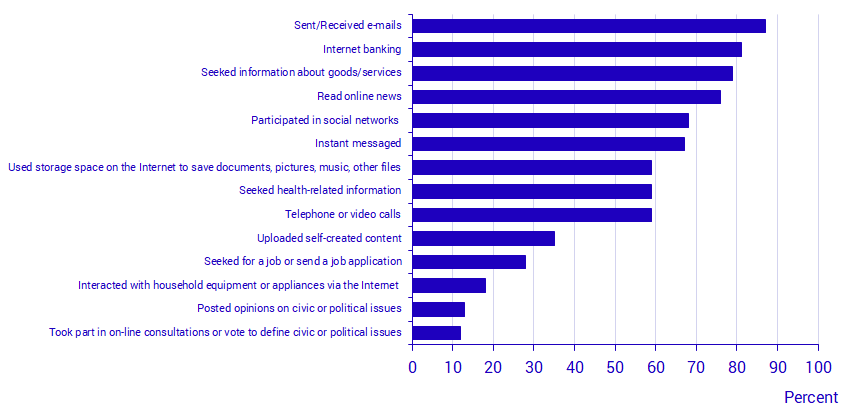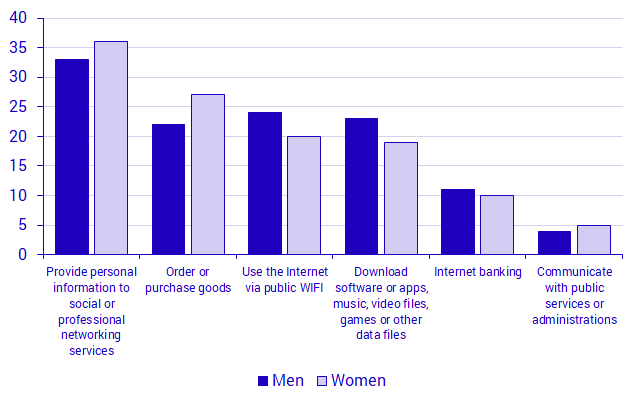ICT usage in households and by individuals 2019
One in three persons has received e-mail from fraudsters
Statistical news from Statistics Sweden 2019-11-22 9.30
This year’s survey shows that 95 percent of Sweden’s population, that is, 7.7 million persons aged 16 to 85, had access to the internet in 2019. In the past year, nearly 200 000 persons experienced economic loss as a result of identity theft, e-mails from fraudsters, or redirects to fake websites.
More and more people in Sweden use the internet almost every day. Among the population, 84 percent use the internet several times a day, and this share has grown by 3 percentage points since 2018. Most people connect to the internet via mobile phone (88 percent), which is 7 percentage points more than last year. People also often connect to the internet via laptop, tablet, and other mobile units such as smartwatch, game console, and reading pad.
The survey measured the use of various activities on the internet and the results show that 79 percent of the population read news online and 67 percent used instant messaging. All activities are presented in the table below.

Despite an increase from 2018 in internet access, this year’s survey shows that more than 340 000 persons (4 percent of the population) in the 16 to 85 age group do not have access to the internet at home. The main reason that persons stated for not having access to the internet at home is that they lack the need, for example because it is not useful or interesting. This year’s survey shows that 2 percent of Sweden’s population does not have access to the internet at home because they do not know how to use it.
More internet use also means more risks
Masses of information are handled digitally on a daily basis. There are incidents of security threats online. The survey shows that, in the past year, nearly 3 million persons have been subjected to ‘phishing’, that is, received e-mails from fraudsters, and that more than 1.2 million persons have been subjected to ‘pharming’, that is, have been redirected to fake websites that requested personal information.
In the first quarter 2019, 65 percent of the population purchased goods and services online. Shopping online is increasingly common and the transactions are increasingly large. Despite this, 12 percent of Sweden’s population has never purchased goods or services over the internet. The main reasons that people stated were that they want to see the product in real life, they have concerns about making payments online, or privacy concerns. In the past year, more than 230 000 persons in Sweden have been subjected to fraud in connection with purchases of goods or services online.
Some activities on the internet were avoided by internet users in the past year due to security concerns. The survey results show that security concerns was the most common reason stated that kept internet users from providing personal information on social or work-related networking sites (35 percent of the population).

Definitions and explanations
These statistics are based on the survey ICT usage in households and by individuals that forms part of Sweden’s official statistics. The survey includes around 130 questions on access to usage of information technology. All statistics presented here and much more can be retrieved from the statistical database on Statistics Sweden’s website.
For questions on how these statistics were produced and a description of the quality, we refer to the documentation Statistikens framställning (2019) and Kvalitetsdeklaration (2019) available on Statistics Sweden’s website. For help with explanations of the results, producing documents or similar, do not hesitate to contact us.
Since 2014, Statistics Sweden has added the age group 74 to 85 years to the sample; for older historical comparisons this total should be used. At the EU level, the age group 16 to 74 years is used. These statistics are published on Eurostat’s website, where comparisons can be made with other EU countries.
The regional estimates are presented at the regional level according to NUTS 2.
Statistical Database
More information is available in the Statistical Database
Feel free to use the facts from this statistical news but remember to state Source: Statistics Sweden.
